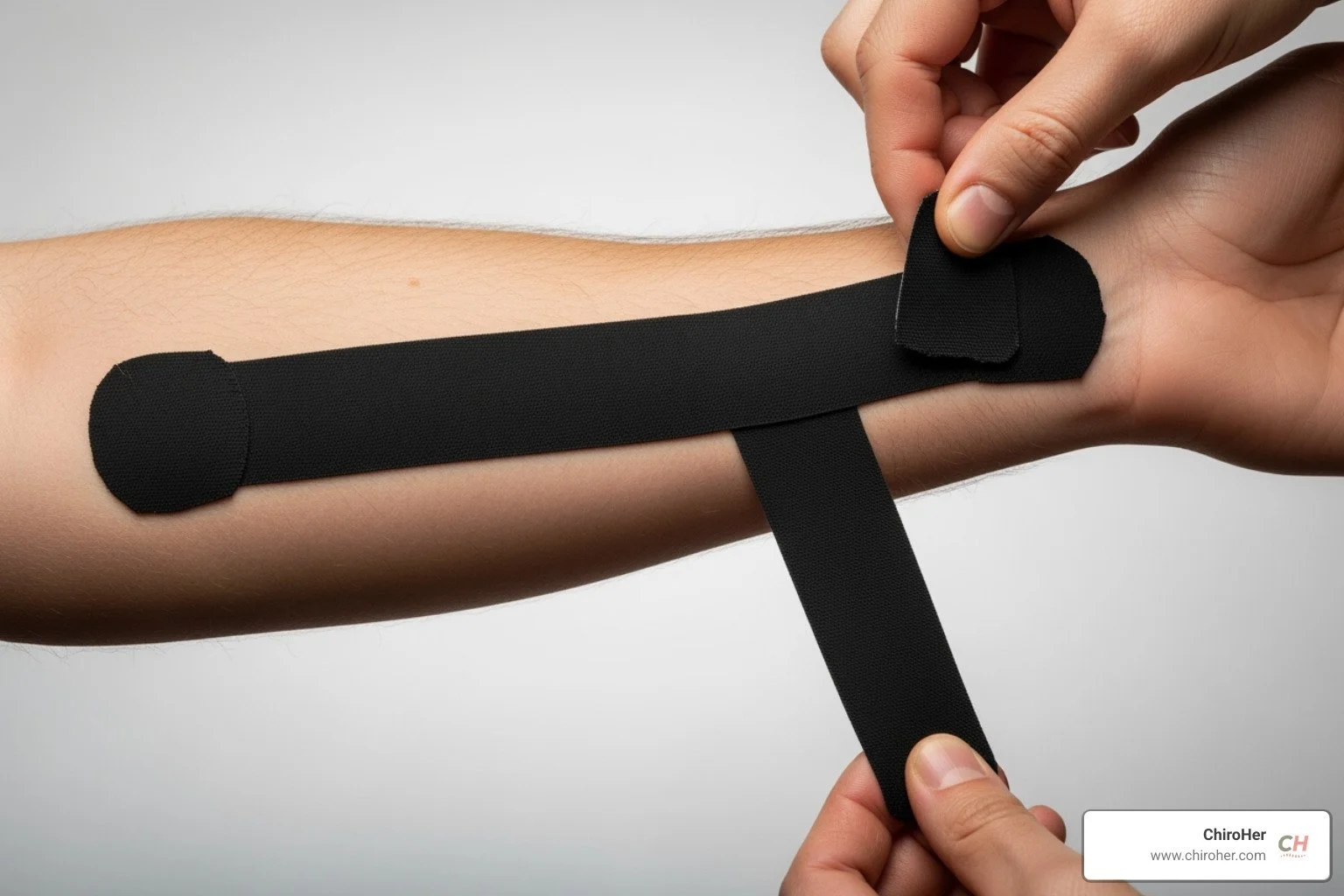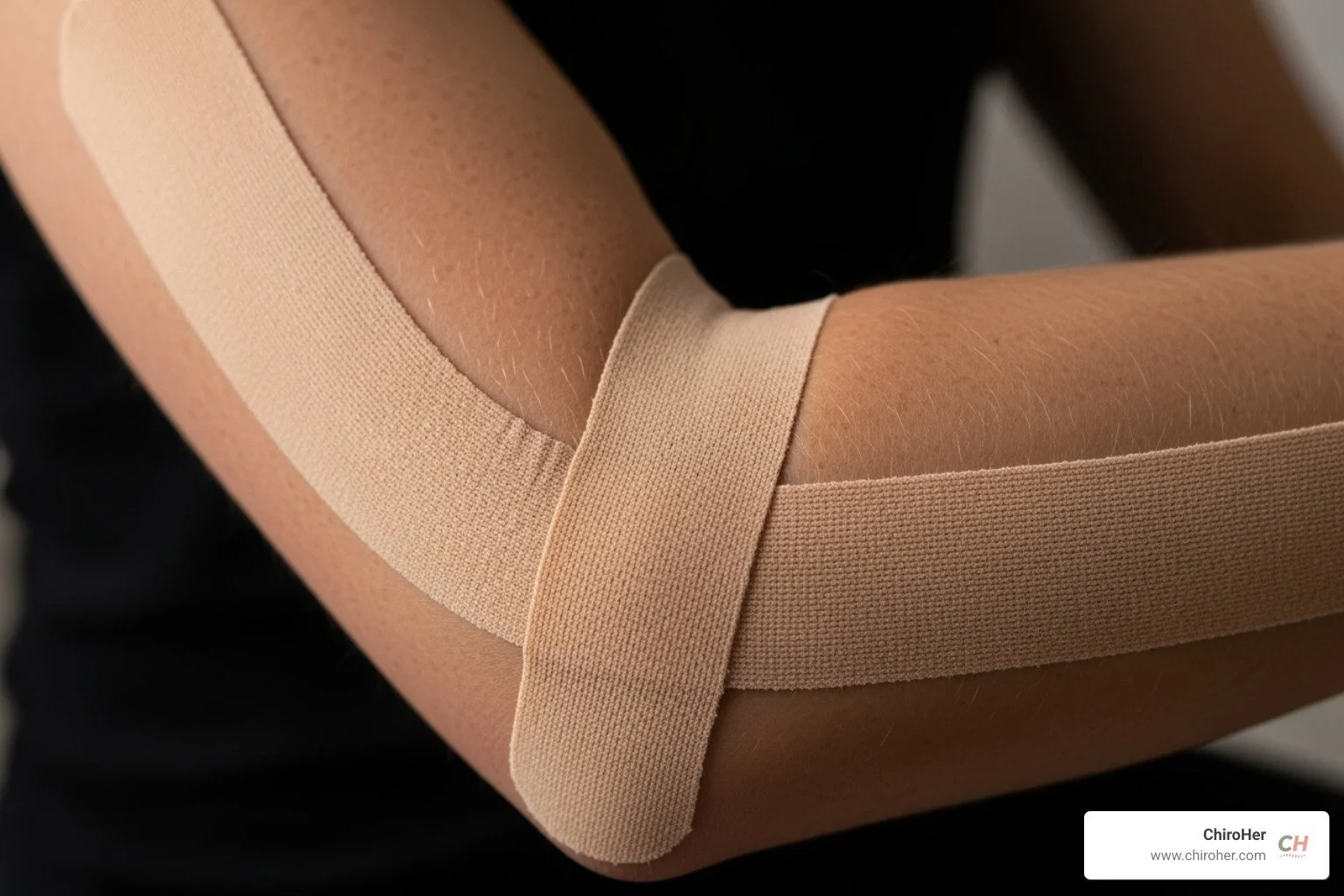Quick Fix: Kinesio Taping Techniques for General Elbow Pain
How Proper Elbow Taping Can Improve Your Daily Comfort
Learning how to kinesio tape an elbow may provide relief for common conditions like tennis elbow and golfer's elbow. Here's the quick method:
Clean and dry the skin around your elbow.
Cut an I-strip of kinesiology tape about 8-10 inches long.
Round the corners to prevent peeling.
Anchor without stretch at the starting point.
Apply 25-50% stretch along the muscle.
Finish with no stretch at the end point.
Elbow pain is a common issue, affecting people from all walks of life. Whether it's the sharp pain of tennis elbow or the ache of golfer's elbow, kinesiology tape offers a drug-free solution that works around the clock.
Research shows that kinesiology taping can reduce tennis elbow pain. The tape works by lifting the skin to decompress underlying tissues, which reduces pressure on pain receptors and improves fluid drainage around the injured area.
I'm Dr. Michelle Andrews, founder of ChiroHer in Oklahoma City. I've helped hundreds of patients find relief with targeted taping. In my practice, I've seen how learning how to kinesio tape an elbow properly can make a significant difference for managing pain and supporting recovery.
Understanding Elbow Pain and Kinesiology Tape
Learning how to kinesio tape an elbow can provide significant relief for many common elbow conditions, often within hours of application.
What Causes Elbow Pain?
Elbow pain often stems from irritation or strain of the muscles, tendons, and ligaments supporting the joint. The most common conditions I treat are:
Tennis elbow (lateral epicondylitis): This causes soreness on the outside of the elbow, often from repetitive forearm movements. It's typically a degenerative condition involving microscopic tendon injury, with pain that can radiate down the forearm.
Golfer's elbow (medial epicondylitis): This affects the inside of the elbow and is linked to strain of the wrist flexor muscles. It can sometimes involve the ulnar nerve, causing tingling in the little finger.
General elbow pain: This is a dull, achy discomfort without a specific spot, common in professions with repetitive hand and arm movements like hairstylists or mechanics.
For more details about how kinesiology tape works with your body's natural healing processes, check out our comprehensive guide on what is Kinesio Tape and how it works.
How Kinesiology Tape Provides Relief
Kinesiology tape is designed to mimic human skin's elasticity. When applied correctly, it helps reduce elbow pain in several ways:
Decompression: The tape gently lifts the skin, creating space to reduce pressure on pain receptors for immediate relief.
Improved Circulation: This lifting effect improves blood flow and lymphatic drainage, bringing nutrients to the area and removing inflammatory waste.
Dynamic Support: Unlike rigid tape, it supports muscles without limiting your range of motion, allowing you to continue daily activities.
Pain Gating: Sensory input from the tape can interfere with pain signals traveling to your brain, similar to how rubbing a bumped elbow feels better.
Better Proprioception: The tape increases your body's awareness of joint position and movement, which helps you maintain proper form and prevent further injury.
Research supports these benefits, showing that kinesio taping can reduce tennis elbow pain. To learn more about the science behind these mechanisms, read our detailed article on how KT tape works.
How to Kinesio Tape an Elbow for Pain Relief
Learning how to kinesio tape an elbow effectively starts with proper preparation and understanding the specific techniques for different types of elbow pain.
Preparing Your Skin and Tape
Proper preparation ensures your tape sticks correctly and lasts longer. Before you begin, gather your supplies: kinesiology tape, sharp scissors, and rubbing alcohol.
Clean and Dry Skin: Remove all oils, lotions, and dirt using soap and water or rubbing alcohol. Let the skin dry completely.
Manage Hair: If you have significant hair on your forearm, consider shaving the area 12 hours beforehand for better adhesion and easier removal.
Test for Allergies: Apply a small test piece to your inner forearm for up to 24 hours. If irritation occurs, do not proceed.
Prepare the Tape: Measure the tape against your arm and cut it to the desired length. Always round the corners to prevent the edges from peeling.
Step-by-Step: Taping for Tennis Elbow (Lateral Epicondylitis)
This technique supports the overworked wrist extensor muscles on the outside of your elbow.
Position Arm: Sit with your arm straight out, palm facing down. Make a loose fist to gently stretch the forearm muscles.
Anchor Tape: Take an 8-10 inch I-strip. Anchor the first 1-2 inches just below the bony bump on the outside of your elbow with zero stretch.
Apply Stretch: Apply the middle of the tape along the outer forearm muscles toward your wrist with a 25-50% stretch. The tape should feel snug, not tight.
Finish Anchor: Lay down the last 1-2 inches of tape just above your wrist with no stretch. Rub the strip to activate the adhesive.
This application reduces the load on affected tendons. For detailed scientific research on the efficacy of kinesio tape for tennis elbow, you can explore the clinical evidence.
Step-by-Step: Taping for Golfer's Elbow (Medial Epicondylitis)
This method targets the wrist flexor muscles on the inside of your elbow.
Position Arm: Extend your arm with your palm facing up, keeping the elbow as straight as is comfortable.
Anchor Tape: Using an 8-10 inch I-strip, anchor the starting point just below the bony bump on the inside of your elbow with no stretch.
Apply Tape: Run the tape across the inner forearm muscle (pronator teres) toward your wrist with little to no stretch.
Finish Anchor: Place the last 1-2 inches of tape just above your wrist with no stretch. Rub to activate the adhesive.
Optional Y-Strip: For extra support, cut a second strip into a Y-shape. Anchor the base over the most painful spot with no stretch, then apply the two tails around the area with a 75-100% stretch.
This technique helps reduce strain on the pronator teres muscle. For more information about various supportive taping techniques, explore other methods we use in our practice.
How to Kinesio Tape an Elbow for General Support
Use this two-strip method for a general ache, weakness, or discomfort.
Position Arm: Hold your arm in front of you with your fingers pointing down to stretch the forearm.
Apply First Strip: Cut an I-strip long enough to run from just above your elbow to just above your wrist. Apply it smoothly down your forearm with 0% stretch.
Apply Decompression Strip: Cut a shorter 4-6 inch strip. Apply the middle of this strip directly over the most painful spot with 50% stretch, perpendicular to the first strip.
Anchor Ends: Anchor both ends of the shorter strip with no stretch. Rub both strips to activate the adhesive.
This combination provides overall support from the first strip and targeted decompression from the second.
Maximizing Results and When to Seek Help
Learning how to kinesio tape an elbow is a great first step. To get the most out of your taping, it's important to understand how to wear it properly and when to seek additional support.
Best Practices for Wearing and Removing Tape
Proper tape care is key for effectiveness and skin health.
Wear Time: Tape can typically stay on for 3 to 5 days. Remove it sooner if you experience increased pain or unusual symptoms.
Watch for Irritation: Remove the tape immediately if you notice itchiness, redness, burning, or blistering. This can sometimes be caused by applying too much stretch at the anchor points.
Safe Removal: To remove, get the tape wet in the shower or with a damp cloth. Peel it off slowly in the direction of hair growth, supporting the skin as you go.
Give Skin a Break: Let your skin rest for at least 24 hours between applications to prevent irritation.
How to Kinesio Tape an Elbow: Complementary Therapies and Next Steps
Taping is most effective when combined with other healing approaches to address the root cause of the pain. A comprehensive recovery plan often includes:
Stretching and Strengthening: Gentle forearm stretches maintain flexibility. As pain subsides, strengthening your shoulders, back, and core is crucial, as many elbow problems stem from weakness in these areas.
Icing and Massage: Icing after activity helps manage inflammation, while gentle massage can improve circulation and release muscle tension.
Addressing Root Causes: Poor conditioning, improper technique in sports or work, and poor desk ergonomics can all contribute to elbow pain.
Professional assessment is important if pain persists, worsens, or is accompanied by numbness or tingling. At ChiroHer, we specialize in finding the root of musculoskeletal issues for our patients in Oklahoma City.
Chiropractic Care: Proper alignment of the spine and nervous system can boost your body's natural healing abilities and help prevent future injuries. Learn more about our chiropractic care services.
Acupuncture: This practice can reduce inflammation and promote healing for various elbow conditions. Find the benefits of acupuncture for pain relief.
You don't have to manage elbow pain alone. If you're dealing with persistent discomfort, we're here to help. Schedule a consultation with us to create a personalized plan that works for you.
This article is for informational purposes only and does not constitute medical advice. The information contained herein is not a substitute for, and should never be relied upon for, professional medical advice. Always seek the advice of your physician or other qualified health provider with any questions you may have regarding a medical condition.





